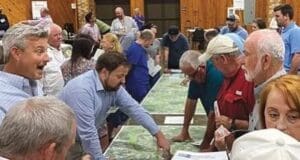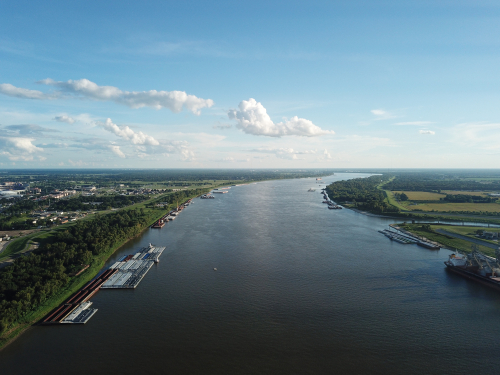Building a new bridge across the Mississippi River in the Baton Rouge area is not a new idea. The need had been there for decades, but getting beyond general conception has proved difficult, for any number of reasons. But today, thanks to a more pragmatic approach to achieving this monumental undertaking, a new Mississippi River Bridge (MRB)-building effort is taking those first critical steps toward becoming reality.
“Some of the attempts over the past 20 years have had bigger ambitions and scope and they were never able to get off the ground, either financially or politically,” says Kara Moree, CFM. “What we’re doing is concentrating on the early phases—selecting a location and getting the environmental documentation—to provide a foundation and build momentum for the project. This approach has been very successful in moving it forward.” Moree is the national director for NEPA & environmental compliance with Atlas Technical Consultants and serves as the overall project manager. Atlas was selected by the Louisiana Department of Transportation & Development (LADOTD) as the prime consultant to conduct an Enhanced Planning Investigation and Environmental Evaluation for a new river bridge, one of the most high-profile civil infrastructure projects in the state of Louisiana.

Project staff members answer questions from the public about the new
Mississippi River Bridge at a community center meeting in April 2022.
As its first order of business, the Atlas-led team was asked to identify approximately 30 possible locations for the new bridge. The project limits were set along 60+ miles of river so, at first glance, it did not appear to be a tall order, but they didn’t get too far into the navigation study before discovering just how many constraints the project would be subjected to. “There were a lot of places we couldn’t put piers in the river. There are anchorages and things of that nature that we needed to stay away from. We were also limited to a 2,000 ft maximum main span length. We consulted with the U.S. Coast Guard and spoke with river pilots and identified other restrictions and impediments. It was difficult coming up with 30 locations, but eventually, we did identify 32,” Moree says.
From there, the team took a tiered approach to narrowing that list down to a more manageable number. Two rounds of screening were conducted in consideration of the project’s purpose and need, which was informed and supported by traffic data and other analyses. “We also had to consider the environmental impacts. We had to determine if we would be able to get permits, whether it was for wetlands or levees or the Coast Guard. There’s also a lot of really big industry up and down the river, and of course, Baton Rouge has one of the busiest ports in the world,” she says. By taking a data-driven approach, the team, which included 13 sub-consultants, was able to back up their decisions with cold facts. This proved particularly beneficial when 10 preliminary alternatives were selected and presented to the public.
As in many areas of Louisiana, Baton Rouge is still dealing with the aftermath of Hurricane Katrina in 2005. Almost overnight, the area took in an additional 200,000 displaced individuals. One of the impacts of that growth was that the metropolitan area hit its projected 2030 traffic volumes 25 years ahead of schedule. A project of this size and potential impact is bound to raise the interests, and passions, of residents and community leaders. Extensive public information and stakeholder engagement efforts were particularly critical in keeping the project moving forward. The team also made quarterly presentations to a state legislative committee so that government and political influencers would be kept abreast of progress.
Although Atlas is a national firm with 100 locations across the country, the MRB project has benefited from a decided home-field advantage. Both Moree and Maria Bernard Reid, NEPA specialist and deputy project manager were born and raised in south Louisiana. Although Atlas is a multi-disciplined firm with the resources to complete a project of this magnitude from start to finish, it benefited from the specialized expertise of its two project leads. “We are not engineers—we’re environmental people. Everything we see, we see through the eyes of biologists and NEPA practitioners. The Federal Highway Administration, who will be reviewing our environmental document, really appreciates having that perspective informing our findings,” says Reid.
That advantage has resulted in what will be the first approved Planning and Environmental Linkages (PEL) document on a LADOTD project. The integrated and collaborative PEL approach asks project teams to consider environmental factors during the planning process, using data and analysis gathered during planning to enhance the environmental investigations and analysis. FHWA encourages its use as a means to save time and cost by minimizing duplicate efforts. “Going straight from planning into NEPA, we fully expect that all of our work will be brought forward. Having two environmental professionals leading that has been a very big plus in producing high-quality and approvable documents,” Reid says.
Atlas is scheduled to complete its work on the MRB project in late 2024. A new governor and administration will be installed in January, and the team is focused on keeping the project moving forward and maintaining the state’s commitment. If all goes according to plan, it will soon be moving toward design and construction.
Published by Engineering News-Record (ENR)
On July 31, 2023
